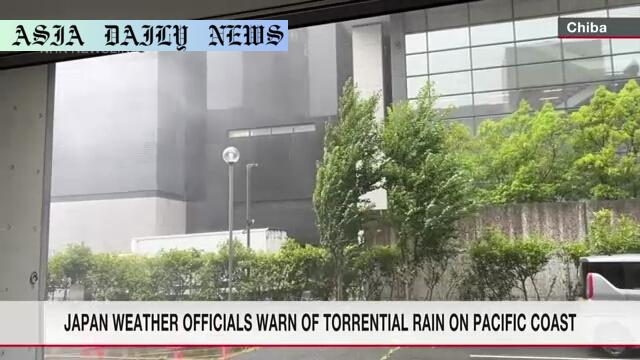Torrential Rain: Japanese weather officials warn of extreme rain conditions for eastern and western regions, urging caution amidst risk of landslides and flooding.
Torrential rain forecasted to impact eastern and western Japan, especially along the Pacific coast through Thursday.
Japanese Meteorological Agency warns against risks of landslides, flooding, and swollen rivers due to unstable atmospheric conditions.
Regions including Tokai, Kinki, and Kanto-Koshin could receive up to 250mm rain, with continued monitoring advised for heatstroke in some areas.

Torrential Rain Threatens Pacific Areas of Japan
Japan’s Meteorological Agency has issued a stern warning about impending torrential rain, which could severely impact several regions along the Pacific coast through Thursday. The atmospheric conditions have become increasingly unstable due to warm and moist air circulating along the outer edge of a high-pressure system hovering around the country. Already, significant rainfall has been observed, with 32 millimeters recorded in Shimada City, Shizuoka Prefecture, within just an hour. The forecast projects even more substantial precipitation, particularly in the Tokai region, where up to 250 millimeters of rain is expected by Thursday evening. Other affected regions include Kinki, predicted to receive up to 200 millimeters, and Kanto-Koshin, anticipating up to 180 millimeters.
Geological Hazards and Risks
The persistent rainfall has severely loosened soil in affected areas, heightening the risk of landslides and flooding, particularly in low-lying regions. Rivers are also at risk of swelling, which poses a further threat to local infrastructure and communities. Authorities are urging residents to stay vigilant and implement safety precautions. With risks of severe weather, the agency has doubled down on its warnings about potential lightning strikes, gusty winds, tornadoes, and even hail. These conditions demand immediate attention and action from people living in vulnerable areas to ensure their safety.
Impact of Warm Conditions and Heat Considerations
Interestingly, while some parts of the country brace for torrential downpours, others are grappling with significantly warmer temperatures. On Wednesday, Sanjo City in Niigata Prefecture experienced a scorching high of 38.1 degrees Celsius. Meteorologists attribute this anomaly to the same warm and moist air system causing rainfall in other locales. This dual weather condition highlights the variability of climate patterns in the country. To combat heatstroke risks, officials recommend staying hydrated with adequate water and salt, ensuring frequent rest, and utilizing air conditioning effectively. This underscores the importance of preparedness and adaptability in the face of unpredictable and extreme weather conditions.
A Unified Call for Preparedness
This week’s weather serves as both a stark reminder and a serious call to action for Japan’s residents. With potential disasters looming, governments and emergency services are likely to ramp up assistance and warnings to vulnerable communities. Preparedness is not merely a recommendation but is becoming an urgent necessity. From early evacuation plans to ensuring accessibility to disaster kits, citizens are encouraged to take proactive steps. Such high-level unification of response measures may play a crucial role in navigating these challenging conditions safely.
The unpredictable combination of heatwaves and torrential rains illustrates how natural phenomena can interconnect to create extreme circumstances. Japan’s response to this dual threat will surely offer critical lessons for global weather response strategies. As these challenges unfold, it’s crucial to prioritize safety and lean on community resilience to combat the impact of the advancing weather system.
Commentary
Understanding the Impacts of Torrential Rain
As torrential rain threatens Japan’s Pacific coast, it serves as a vivid reminder of how natural forces can disrupt daily life. This story reflects an interconnected weather system’s sheer complexity and demonstrates the necessity of both structural preparedness and individual awareness to combat climate vulnerabilities. When meteorologists point to a destabilizing atmosphere caused by warm and moist air at the edges of high-pressure systems, they signal that climatic shifts are adding layers of unpredictability to these events.
Balancing Dual Realities: Rain and Heat
What’s striking about this event is the simultaneity of extreme conditions. While some areas are drenched by flooding and landslides, others battling the heat are reminded of the coexistence of separate yet related weather phenomena. The sight of densely saturated areas and rivers swelling beyond their limits starkly contrasts with individuals reportedly braving 38-degree weather further north. This juxtaposition underscores the importance of meteorological research in understanding dual weather challenges. It’s also a wake-up call to ensure infrastructure in regions facing both flooding and heat are adaptive, resilient, and responsive to evolving climate risks.
Preparing for Future Disruptions
Preparedness in the face of such dual crises requires more than physical preparation. It needs a cultural shift in how communities think about early warning systems and environmental responsibility. While localized actions—like accessing air conditioning or preparing an emergency evacuation kit—show individual resilience, broader policies need to enhance collective survival infrastructures. Investment in flood defenses, urban drainage systems, and hydration awareness programs can help communities adapt to these sometimes-overlapping conditions prominently featured in Japan’s news cycle today.
Ultimately, Japan’s ongoing efforts in disaster readiness must evolve as nature’s unpredictability challenges established norms. Whether it’s avoiding heatstroke or mitigating the impact of heavy rainfall, a comprehensive, science-led approach is the way forward. Observing how Japan manages these climatic challenges will provide valuable lessons for the rest of the world as extreme weather becomes a seemingly unstoppable trend.


